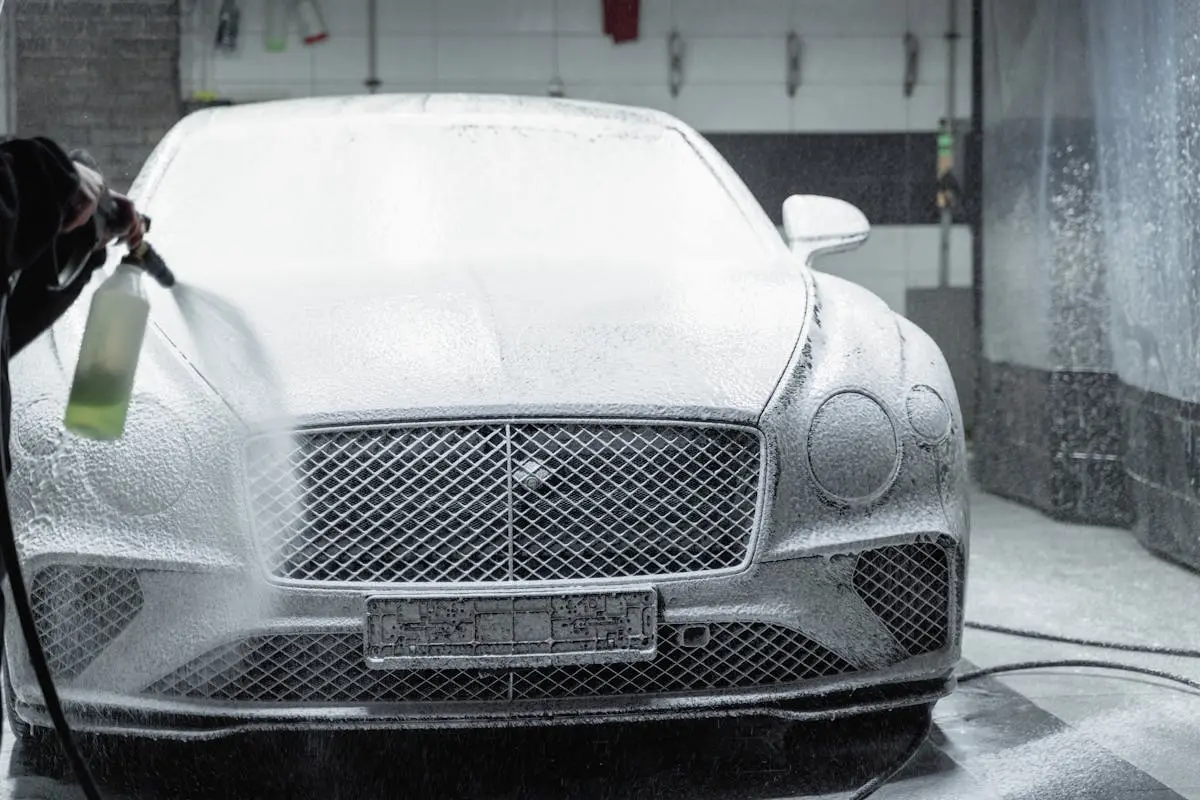Maintaining your car’s pristine appearance can be a challenging task, especially with the daily wear and tear it endures. If you’re looking for a way to keep your vehicle looking brand new, paint protection film might just be the solution you need. In this blog, we’ll break down everything you need to know about paint protection film, from what it is to its benefits and installation process.
What is Paint Protection Film?
Paint Protection Film (PPF) is a transparent, durable layer of film applied to your car’s paint to protect it from scratches, dings, and other damage. Originally developed for military use, it has now become popular among car enthusiasts and owners looking to preserve their vehicle’s look.
The key feature of PPF is its transparent nature, which means it won’t alter your car’s original paint color or finish. This makes it a versatile option for all types of vehicles, whether you own a classic car, a luxury model, or a daily driver. Thanks to advancements in technology, most modern PPFs also have self-healing properties that allow minor scratches and swirl marks to disappear over time. This ensures that your car maintains its pristine appearance for longer.
The film consists of multiple layers, including a urethane layer that acts as the primary protective barrier. This provides resistance against various forms of damage like stone chips, bug splatters, and even bird droppings. The thicker the urethane layer, the better the protection it will offer. Additionally, the film is flexible enough to conform to the contours of your vehicle, offering seamless coverage that doesn’t detract from its aesthetics.
The Benefits of Paint Protection Film
There are numerous benefits to using paint protection film on your vehicle. These include protection against road debris, minor abrasions, and even harmful UV rays. Additionally, paint protection film can help maintain the car’s resale value by keeping the exterior in good condition. Imagine being able to drive on highways without worrying about rocks or debris causing unsightly chips to your car’s front end. PPF provides this peace of mind and makes it much easier to keep your car looking like it just rolled out of the showroom.
Another significant advantage is the self-healing properties of many modern PPF products. This means minor scratches and swirl marks can disappear over time, keeping your car looking flawless without frequent touch-ups. The ability to self-heal is particularly beneficial for those who often drive in areas with a lot of dust and small debris, which can cause fine scratches on the vehicle’s surface.
Furthermore, paint protection film offers an additional layer of UV protection. Prolonged exposure to sun rays can cause the paint on your car to fade over time, dulling its vibrant color. PPF acts like a sunscreen for your car, reflecting UV rays and keeping your paint job looking fresh for longer. This is particularly valuable if you live in a region with intense sunlight or if your car spends a lot of time parked outdoors.
Perhaps one of the most understated benefits of PPF is how it simplifies maintenance. With a PPF layer, dirt and grime are less likely to adhere to the car’s surface, making washing your vehicle a breeze. A simple rinse will often remove most of the dirt, keeping your car cleaner with less effort.
Types of Paint Protection Film
There are different types of paint protection films available, each with its own features and benefits. Some of the most common types include thermoplastic polyurethane (TPU) and polyvinyl chloride (PVC) films. TPU films are known for their durability and self-healing properties, while PVC films are often more affordable but may lack some of the high-end features.
Thermoplastic Polyurethane (TPU) is generally considered the gold standard for paint protection films. Its flexibility allows it to conform seamlessly to the curves and contours of your vehicle, and its durability means it can withstand impacts better than other materials. TPU’s self-healing properties—activated either by heat or simply over time—make it an excellent choice for long-term protection.
Polyvinyl Chloride (PVC) films, on the other hand, offer a more budget-friendly option. While they might not have the self-healing properties of TPU films, they still provide good protection against scratches and minor abrasions. PVC films are a viable option for those looking for a cost-effective way to protect their vehicle’s paint without compromising too much on quality.
It’s also worth noting that some premium PPF brands incorporate additional layers for enhanced UV and chemical resistance. Before deciding on a type of film, it’s crucial to consider your specific needs and the environmental conditions your vehicle will be exposed to. Consulting with a professional installer can help you make the best choice for your car.
How is Paint Protection Film Applied?
The application process of paint protection film is a meticulous one and commonly performed by professionals. It involves thoroughly cleaning the car’s surface, cutting the film to size, and carefully applying it without bubbles or imperfections. Precision is key to ensure a seamless and nearly invisible layer of protection. The effort put into a detailed and precise application ultimately determines the effectiveness and longevity of the film.
It’s worth noting that DIY kits are available for those who prefer to tackle the task themselves. However, due to the precision required, professional installation is often recommended to achieve the best results. Professionals possess the experience and specialized tools necessary to apply the film evenly and without the risk of damage. Additionally, a professional application often comes with a warranty, providing peace of mind that your investment is protected.
When you opt for professional installation, you can expect a multi-step process designed to ensure optimal adherence and durability. First, the vehicle undergoes a thorough wash to remove any dirt and contaminants. Next, the installer may use a clay bar to further clean the surface, removing any remaining impurities. Once the surface is immaculate, the film is carefully applied, often using a slip solution to help position it correctly. Finally, a squeegee is used to remove any bubbles or moisture between the film and the paint. This meticulous approach ensures that the film is virtually invisible and exceptionally effective.
At Viliura Mobile Detailing, we specialize in professional PPF installation tailored to the unique needs of each vehicle. Our technicians are trained to handle the most complex curves and edges, ensuring a perfect fit every time.
Maintaining Your Paint Protection Film
Once your paint protection film is installed, proper maintenance is crucial to ensure its longevity. Regular washing with mild soap, avoiding harsh chemicals, and staying away from automatic car washes with stiff brushes will help keep the film in good condition. It’s also essential to inspect the film periodically for any damage or lifting edges, which can usually be repaired or replaced.
One of the best practices for maintaining your PPF is to use a gentle hand wash rather than an automatic car wash. Automated systems can be abrasive and may cause the edges of the film to lift. Instead, a soft microfiber mitt and a pH-neutral car soap will clean the film without causing damage.
You should also pay attention to the type of cleaning products you use. Avoid any products with ammonia or harsh solvents, as these can break down the adhesive on the film and reduce its effectiveness. Instead, opt for car care products specifically designed for use with paint protection film.
Maintenance isn’t just about keeping the film itself in good condition; it’s also about protecting the underlying paint. Periodically waxing your vehicle with a PPF-safe wax can add an extra layer of protection and keep your car looking shiny and new. Just be sure to use waxes that are compatible with PPF, as some formulations can leave a residue or harm the film.
Cost and Investment Considerations
The cost of paint protection film can vary widely based on the type of film, the size of the vehicle, and whether you opt for professional installation. While it can be a significant investment, many car owners find that the long-term benefits greatly outweigh the initial expense. By protecting the paint and preserving the car’s appearance, PPF can help save money on future repairs and repainting jobs.
When you’re weighing the cost of PPF, it’s important to consider the potential savings in terms of maintenance and repair. For instance, a high-quality PPF can prevent the need for paint correction services, which can be quite costly. Over the years, the film can also act as a buffer against environmental elements like acidic bird droppings and tree sap, which can cause lasting damage if not promptly removed.
In addition to monetary savings, there’s also the convenience factor. With PPF, you’ll spend less time worrying about chips and scratches and more time enjoying your car. When you consider all of these benefits, it becomes clear why paint protection film is a worthwhile investment for any vehicle owner.
At Viliura Mobile Detailing, we offer competitive pricing for PPF installation, making it an accessible option for car owners in the San Francisco area. Reach out to us for a price estimate and find out how we can help keep your car looking its best.
Wrapping Up
Paint protection film is an excellent investment for keeping your car in top-notch condition. Whether you’re concerned about scratches, chips, or environmental damage, understanding the ins and outs of PPF can help you make an informed decision. We hope this guide has made the concept of paint protection film clearer and has provided you with the knowledge you need to take the next step in protecting your vehicle. For high-quality installation and further information about keeping your car looking its best, visit Viliura Mobile Detailing’s website.


